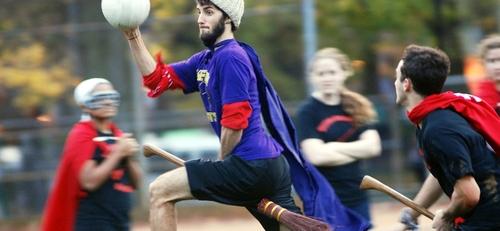Sports editor Rob Moysey finds out why so many sports clubs at Ryerson crash and burn before they’re barely off the ground
Every Sunday in the quad, Sam Racine and Suraj Singh can be spotted setting up quidditch equipment for team practice in the afternoon.
They haul the heavy makeshift hoops from storage at Church and Shuter Streets, dragging a cluster of brooms and balls behind them. They are constantly updating the team’s social media accounts to make sure all members are on the same page. And they tirelessly teach new players the rules of the game without batting an eye.
But all of their work could be in vain.
Ryerson is reluctant to even partially fund or promote its sports clubs, leaving virtually all of the legwork to the club founders. Couple that with the severe lack of room to play on campus and a graveyard of dead clubs begins to form — cricket, rugby, and poker are just a few.
Though the recent athletics referendum padded the coffers of Ryerson sports and recreation, that money is being poured into varsity sports and facilities like Maple Leaf Gardens — initiatives athletics director Ivan Joseph feels do more to bolster the athletic profile of Ryerson.
“Clubs are more here for socialization and community engagement. Their role isn’t to boost the athletic profile of the school — that’s for varsity sports to do. There’s just not enough resources to give them all money.”
Right now, just about any group of students can start a club, but they must be entirely self-sufficient with team costs, promotion, and the $500 team supervisor fee. All the university does is organize gym space and equipment storage, both of which are virtually non-existent.
Randy Pipher, Ryerson’s intramural and camps coordinator, is responsible for managing clubs. He bases his decision largely on the availability of facilities and perceived sustainability of the club.
“Some clubs might have low numbers to start, but we know it will be around years later,” he said. “[But] we need to see the interest first before we dole out a bunch of money for it.”
The utter lack of facilities at Ryerson can kill even the enthusiastic interest. Currently, the RAC only has gym time available at inconvenient times like weekday mornings and weekend nights.
“Are you going to get clubs and students to come practice in the morning? Probably not, unless they’re really dedicated. We’re even finding that it’s hard to get students to come play intramurals on the weekends because they have to work to pay tuition,” said Pipher.
Ryan Stratton, a former radio and television arts student, toiled for three years trying to start up a rugby club before ultimately giving up.
He had 100 students interested in playing, an arrangement with the University of Toronto to practice on their field, and a season organized between nearby Toronto universities, yet it was still not enough to coax the university into cooperation.
“They didn’t say it was a good idea, they were just buzz kills. All they did was say ‘Here’s all the money you have to pay, here’s all the forms you have to fill out, here’s all the negatives’,” said Stratton. “We didn’t need money, we had guys willing to pay. We just needed support.”
Stratton’s rugby team paid only $40 per semester compared to other clubs like cheerleading, which pays $200. He even worked out a deal with local bar Filthy McNasty’s to sponsor the team in exchange for an advertisement on their jersey. But Ryerson shot down the team’s sponsor because the university doesn’t want alcohol-related sponsors on jerseys.
“If we could have had our sponsor, Ryerson rugby would have been free,” said Stratton.
Pipher points to the absence of a field near campus for the team’s failure, but Stratton argues the team had a bevy of talented players that were committed.
“There’s tons of talent in Toronto and rugby is on the rise. U of T has an OUA team already, but with our talent we could beat those guys,” said Stratton.
Stratton served as his team’s supervisor and donated the $500 back to the team, but once he graduated and a few senior members left, the team fell apart.
So what does this mean for the quidditch team? Like rugby, they need a field bigger than the quad to play on that is nowhere to be found. They need a place to store their equipment, but no space in the RAC exists. And they need a supervisor to officiate their games for the season, which they haven’t found yet.
Aside from that, it is going to take a herculean recruiting effort for the team to succeed where others have failed. Most importantly, the team is going to need a solid base of leaders to organize the team once the original founders move on — something the rugby team never had. “We hope we can get a lot of froshies involved,” said Sam Racine.
“We need to make sure there are people to continue what we’ve started when we’re gone so it goes on for years and years.”
Photo courtesy of the Ryerson Quidditch Team










Leave a Reply